Title: "Solana: Past, Present, and Future"
Source: Nansen
Author: Sandra Leow
TL;DR
Since the beginning of this year, the total locked value (TVL) of Solana has almost doubled, reaching 30.95 million SOL. Despite facing challenges such as network interruptions and the FTX/Alameda incident, Solana has achieved 100% uptime from the beginning of the year, demonstrating significant improvements and recovery capabilities of the network.
Solana has introduced solutions such as state compression and isolated fee markets to address prominent issues in its technical stack. For example, state compression technology has reduced the cost of minting NFTs on Solana to 1/2000 of the original cost.
The field of liquidity staking is rapidly developing, with Marinade Finance, Lido, and Jito leading the way. Only 3-4% of staked SOL is locked in Solana's liquidity staking protocols, indicating significant growth opportunities.
There is increasing interest in enterprise adoption and payment rails, especially with Visa integrating USDC settlement on Solana, the growth of liquidity staking on Solana, and partnerships with entities like Shopify.
Other potential drivers for Solana include the successful implementation of the Firedancer vision and continuous development of consumer-facing applications leveraging Solana's advantages.
However, potential challenges such as the uncertainty of FTX/Alameda holding SOL may pose temporary obstacles to its growth trajectory.
Solana's Positive Momentum and Challenges
Positive Momentum
More Enterprises Adopting Solana Virtual Machine (SVM)
If more institutional participants recognize Solana's continuously improving technical stack (high TPS compared to peers in the blockchain space, addressing downtime issues, economically efficient on-chain storage) and decide to openly collaborate and leverage the Solana network, Solana's reputation will be further enhanced. Some use cases adopting Solana include Visa introducing Solana as a settlement layer to facilitate cross-border USDC payments, and the new payment system Solana Pay on Shopify (in collaboration with Mastercard). Compared to other chains in the market, Solana's key value proposition lies in low transaction costs and high network speed (with a transaction per second or TPS of approximately 3,000, 30 times that of Ethereum and Layer 2 TPS).
Solana developers are actively advancing the Firedancer vision, and interest in SVM is growing.
Firedancer can be said to be one of the most exciting upgrades for Solana. It could facilitate significant optimizations for validator clients and should run more efficiently than the current Solana Labs client.
Currently, the cryptocurrency narrative is primarily 97% Ethereum Virtual Machine (EVM) and 3% SVM. If SVM continues to gain market share from EVM, the Firedancer upgrade and improvements in hardware/bandwidth efficiency could help accelerate the adoption of SVM.
Growth of JitoSOL and other liquidity staking tokens
Jito Labs is the latest "success story" for Solana in the liquidity staking field. The growth of JitoSOL has staked over 2.4 million SOL within a year, which is an impressive feat for the Solana ecosystem, benefiting many dApps. Ethereum has over 40% of staked ETH deposited in liquidity staking protocols, whereas Solana only has approximately 3-4% of staked SOL. If the staked SOL on Solana can continue to grow in LSD form, even a small portion of this would help increase the total TVL of the Solana ecosystem. Solana's staking yield is currently double that of Ethereum, and historical risk statistics are also close.
More consumer-facing applications recognizing Solana's advantages
Solana has proven to be the most usable chain when building consumer-facing applications. The blockchain provides a mature technical stack optimized for retail adoption. Solana's cNFTs are suitable for large-scale NFT minting, optimized for low costs, the native fee market aims to eliminate unnecessary congestion on the network, and the high TPS environment provides the speed required to drive these applications.
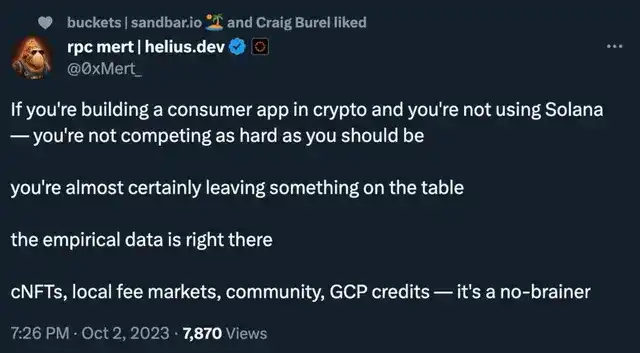
Launch of native tokens for Solana-centric protocols
The crypto community often wonders why most Solana DeFi applications have not yet launched their own native tokens. The answer is simple: protocols typically want their user base and activity to reach a certain threshold before releasing tokens. The token economics of DeFi protocols indicate that native tokens often tend to overinflate and are usually accompanied by pump and dump schemes. However, the issuance of native tokens for DeFi protocols is often a necessary step in the lifecycle of DeFi protocols.
Challenges
If Galaxy chooses to completely liquidate its SOL holdings in a short period, SOL price will drop to the level after FTX
If Galaxy sells its entire SOL position from FTX/Alameda in a short period, the SOL price may react negatively due to the sale on the open market (assuming some of its SOL may be traded over-the-counter). If the price of SOL retraces to the level after the FTX incident, it may cause market panic.
Another network outage would damage Solana's reputation
So far this year, Solana has maintained 100% uptime, which is a very positive record for the network. Any future network outages would have a negative impact on Solana's reputation and confidence in its recent technical upgrades.
Lack of cross-chain bridge infrastructure and native assets
Despite significant developments within the Solana ecosystem, there is still a lack of on-chain liquidity, native asset support, and insufficient bridge infrastructure. Additionally, the ecosystem still needs to address "leaks" in bridging.
Macro Data
TVL
Solana's TVL is 30.95 million SOL, compared to 25.12 million SOL at the beginning of the year. Since the beginning of the year, Solana's TVL (calculated in USD value) has almost doubled and continues to show a sustained upward trend as shown in the chart.
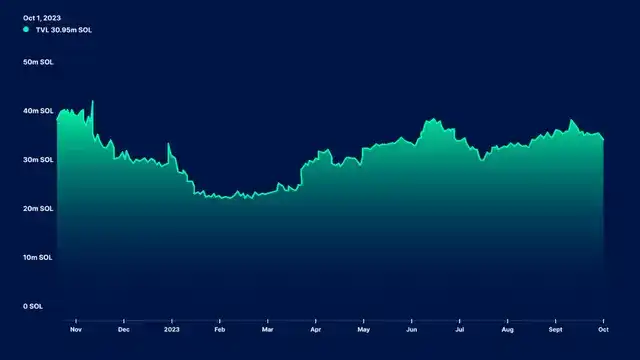
Solana has previously dealt with some urgent issues, such as the FTX/Alameda incident, network outages causing downtime, and spam transactions congesting the network. However, most issues have been resolved through improvements in the technical stack, which will be further explored in the later part of this report. It is noteworthy that Solana has maintained 100% uptime from the beginning of the year.
DeFi Velocity
The transaction volume per 1 USD TVL can be used to measure chain activity and adoption, as TVL often cannot accurately reflect subtle differences in user behavior. In terms of "DeFi Velocity," Solana remains one of the most active chains, with a transaction volume ratio of 0.71 per 1 USD TVL (over the past 7 days).
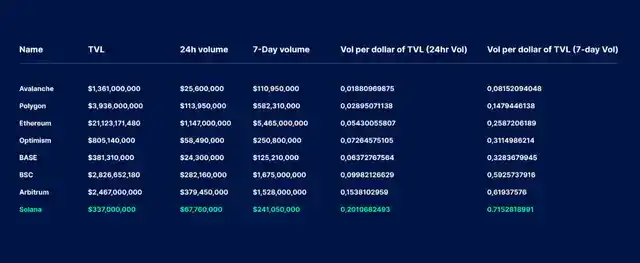
The "DeFi Velocity" metric, i.e., "24-hour DEX trading volume / blockchain TVL," indicates the level of activity in the DeFi ecosystem. A higher value represents a more active DeFi ecosystem. For Solana, for every 1 USD of liquidity, the weekly trading volume is approximately 0.71 times (as of October 2, 2023). Compared to networks such as Arbitrum, Binance, Base, Optimism, and Ethereum, Solana has provided the highest DeFi Velocity in the past 24 hours and 7 days. Interestingly, some chains report higher TVL numbers, but the utilization of DeFi funds is much lower than Solana, indicating lower on-chain economic activity.
Let's narrow the scope and consider the monthly cross-chain DeFi Velocity from a longer-term perspective.
Daily Transaction Volume
This year, Solana's daily transaction volume has remained relatively stable, with an increase in voting transactions. Transactions on Solana are a combination of voting and non-voting transactions. Voting transactions are linked to voting accounts owned by validators, including configuration, registration, vote collection, and new vote signatures.
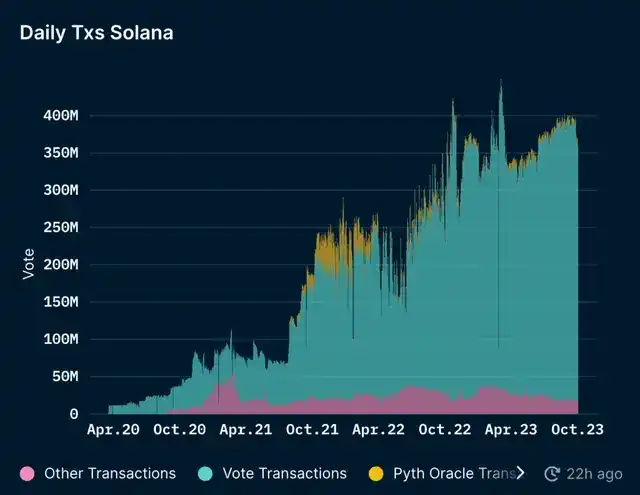
Decentralization
Client Diversity
Having diverse clients is crucial for reducing any single point of failure in a given blockchain.
Solana is developing over 4 validator clients for the Solana network. In addition to Solana Labs, the proportion of validators running through Jito-Solana Client is increasing, accounting for almost one-third of the total validator token amount. Since the Solana Foundation's last validator health report in March, the number of validators using Jito has almost doubled.
Efforts are currently underway to create more complete or lightweight validator clients on Solana, including Jito Labs, Firedancer, Sig, and Tinydancer. For more detailed information on validator clients, please refer to the latest report from the Solana Foundation on network validator health.

Geographical Distribution
Solana currently has 2,919 nodes distributed across 31 countries and 211 cities globally. The United States ranks first in terms of the number of nodes, followed by Germany, Canada, and Lithuania. The United States has 1,370 nodes, accounting for almost half of the total nodes. Concentration of nodes in the United States may pose slight risks, but it is worth noting that the nodes are distributed across different regions in the United States in validator clusters.
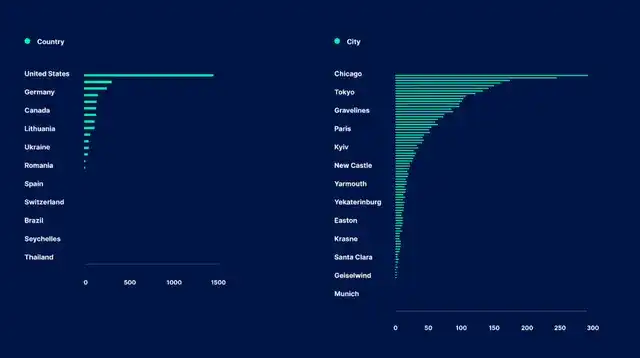
Nakamoto Coefficient
The Nakamoto Coefficient is an indicator of the minimum number of independent entities required to collude to shut down a blockchain. According to this framework, the higher the coefficient, the more decentralized the blockchain. In a typical proof-of-stake network (such as the networks listed below on Nakaflow), the Nakamoto Coefficient is defined by the proportion of node operators who collectively control over one-third (33.33%) of all stakes on the network. Since its inception, Solana's Nakamoto Coefficient has been steadily increasing and has remained relatively stable at 30-31% over the past year. However, it must be emphasized that the Solana Foundation controls approximately 20% of the stakes and delegates them to small and medium-sized validators.
When measuring the degree of decentralization, relying solely on the Nakamoto Coefficient is not enough. Other metrics such as geographical diversity, data center ownership, and validator client diversity should also be considered. The Firedancer upgrade and Jump Crypto's "Firedancer" client are driving client diversity, which will be further studied in the later part of the report.
Catalysts, Drivers, and Challenges
Alameda / FTX Selling SOL
FTX is the largest holding entity of SOL, locking and holding over 71.8 million SOL (valued at approximately 11.6 billion USD). This represents 17% of the circulating supply of SOL (as of the time of writing), equivalent to approximately 13% of its total supply. Disclaimer: Not all holding accounts are public, and non-public accounts may impact certain data. Special thanks to SolanaFM for providing the data.
What we know:
Alameda and FTX collectively hold approximately 1.3 billion USD worth of crypto assets, including SOL, BTC, ETH, and APT.
Their hot wallet addresses are:
- 9uyDy9VDBw4K7xoSkhmCAm8NAFCwu4pkF6JeHUCtVKcX
- 6wEMcwrcF5AP9jpHWQcPxHXciWA2g217Qq81CTWjbgBw
- 6b4aypBhH337qSzzkbeoHWzTLt4DjG2aG8GkrrTQJfQA
- The hot wallet addresses hold 6.98 million SOL.
Their staking wallets total three, holding a total of 65 million SOL.
Among the staking accounts, 61 million SOL is held, including 52 million SOL locked in staking.
Additionally, there are 3.8 million SOL in a locked state.
Galaxy Digital is pushing for Alameda and FTX to sell their shares, but the timing of this process is unclear. The weekly limit for the sale of tokens is 100 million USD (including hedging) to limit price fluctuations.
What we don't know:
The 52 million SOL locked in staking will be unlocked by 2027, with one Alameda / FTX account unlocking 7.5 million SOL on March 1, 2025. Despite these SOL being locked/staked, FTX liquidators still have the right to fully liquidate all SOL held by FTX/Alameda.
We cannot determine the impact of SOL liquidation or sale on the market, as Galaxy Digital may conduct as much over-the-counter trading as possible. Galaxy Digital may also choose to sell in batches, fully liquidate SOL, or use other alternative methods that we may not be able to verify on-chain. Another point to note is that SOL over-the-counter trading by FTX/Alameda may alleviate some buying pressure in the market.
Ecosystem Highlights
Recent developments in Solana's ecosystem are positive:
September 2023: Visa introduced USDC settlement on Solana. This is particularly noteworthy when considering future payment architectures and other use cases involving interactions between public blockchains and private (or public) financial entities.
Development and Partnerships
Solana's State Compression
State compression is an on-chain solution that significantly reduces storage costs. It involves storing a large amount of data off-chain (such as NFT data in this case) and preserving its "footprint" on-chain using Merkle trees. This compression-friendly data structure allows developers to store smaller data on-chain and update it directly on the Solana ledger, reducing data storage while still retaining Solana's base layer.
Comparing the cost of minting NFTs with and without state compression technology, the cost of minting 1 million NFTs on Solana was $2.53 million before the introduction of state compression, and only $113 after enabling state compression. In contrast, a similar scale of collection would cost $33.6 million on Ethereum and $3.28 thousand on Polygon.
Without the state compression upgrade, minting collections on Polygon is actually much cheaper than on Solana. Clearly, Solana has gained a significant advantage in compression technology, greatly reducing the cost of minting and trading NFTs.

Source: Flipside
For a more in-depth article on NFT compression and its technical workings, please refer to Helius's article.
Solana's state compression technology is being applied across the ecosystem, benefiting many projects. In summary, Drip Haus and Mad Lads have become the top two series in the compressed NFT space, collectively minting 7.4 million and 5.9 million NFTs.
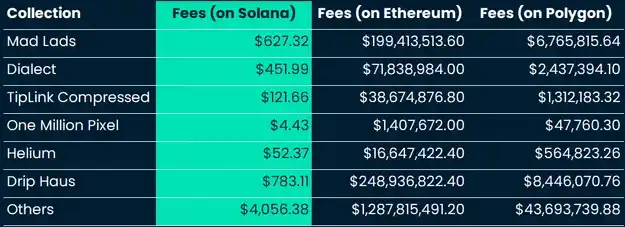
Source: Flipside
Note: Costs are estimates and depend on the prices of each asset within a given time frame. The above costs are calculated based on the prices of Solana, Ethereum, and Polygon on October 2, 2023.
Here are some interesting use cases of Solana's state compression to date:
DRiP
DRiP recently reached a milestone by minting the 1 millionth Solana NFT, making it the largest NFT collection on any chain.
In background, DRiP offers free NFTs to its users weekly. The artist community on Solana creates NFTs, and the ability to mint NFTs at this scale is solely attributed to Solana's state compression.
Mad Lads
Mad Lads is the first xNFT (executable NFT) collection, a new token standard that allows code tokenization.
In essence, xNFT can be seen as a dApp that users can access directly from their wallets. It is very similar to the plugin functionality on Google Chrome. Additionally, xNFT is a programmable dynamic asset and runs on the Solana blockchain using the React xNFT framework. In contrast, regular NFTs are static and non-programmable.
Backpack is the platform that supports the Mad Lads wallet. It is where the first minting and management of Mad Lads NFTs takes place, serving as the execution environment for xNFT.
Crossmint
Crossmint is an NFT infrastructure for developers to seamlessly build NFT applications.
Dialect
Dialect is a messaging platform on Solana that has gained popularity by leveraging the compression capabilities, allowing creators to mint and distribute NFTs to users on the platform.
For a technical breakdown of the technology behind such large-scale in-app sticker production, see the case study on Solana at Dialect.
In essence, the introduction of state compression reduces infrastructure costs (provision and storage of "text" or NFTs in this case, as well as commodity costs) to almost negligible figures.
Dialect has released its first NFT collection and allows users to claim for free. This is objectively impossible on Ethereum or any other L1/L2.
DePIN Narrative
The narrative of DePIN benefits from state compression technology. DePin stands for Decentralized Physical Infrastructure Networks. Over the years, we have seen explosive growth in DePIN networks, from mapping to energy to logistics, some of which are unique to Solana. Kuleen Nimkar, head of dePIN at the Solana Foundation, also stated that dePIN is reshaping traditional infrastructure models, providing opportunities similar to today's gig economy. Over time, we can see people earning additional income by contributing hardware to the dePIN protocol.
Helium
Helium is a decentralized wireless network supporting hotspots in over 170 countries/regions and providing 5G services in some cities in the United States. Helium initially began building its own hotspots in the network development phase and then turned to open-source its hardware specifications.
Helium mints each hotspot as an NFT—supported by Solana's state compression technology. The cost of minting NFTs is only a fraction of a cent compared to minting uncompressed tokens. Helium is one of the earliest DePIN businesses. Hivemapper is an example, a decentralized mapping network that recently started using Helium to verify the location of each driver.
Hivemapper
Hivemapper is a decentralized mapping network essentially building and distributing its own hardware dashcams. Hivemapper also controls the entire manufacturing and distribution process, giving it complete autonomy over its supply chain.
Hivemapper provides tokens to drivers who install the "dashcams" and collects map data as they drive.
Render Network
Render Network allows individuals to contribute unused GPU capacity to help projects render dynamic graphics and visual effects. It recently announced its expansion from Polygon to the Solana blockchain.
QUIC
QUIC Protocol and Local Fee Market
QUIC has replaced UDP (User Datagram Protocol), which was Solana's previous transaction propagation protocol. Solana previously used a protocol based on raw UDP to handle transaction messages from clients to the main validator clients. UDP was unable to handle certain transaction filtering within the network, leading to past network outages.
QUIC is currently used as the default transaction ingestion protocol, providing better control of data flow to avoid issues like spam attacks. Designed for fast asynchronous communication like UDP, QUIC also features session and traffic control similar to TCP (Transmission Control Protocol). This upgrade provides more control over network traffic and is more optimized for data ingestion, addressing Solana's outage issues. Since the deployment of QUIC, Solana has maintained 100% uptime.
Local Fee Market
Solana's network has introduced priority fees on top of the existing base fees. The local fee market allows any user to send priority fees to validators. Previously, users had to send spam transactions to the network to ensure their transactions were processed with priority, leading to network congestion. Additionally, the quantity of invalid or duplicate messages sent by users or algorithms could increase the total cost. Clearly, priority fees are crucial for block inclusion and transaction queue ordering, but they also increase the cost of network spam attacks.
Priority fees can also serve as a proxy for activity occurring within the network. The increase in priority fees (as a percentage of total fees) can also be attributed to the growth of economic activity on the network, such as large-scale NFT minting and DeFi activities.
Currently, priority fees are calculated based on the expected computational resources needed for transactions. For example, simple transactions for DeFi activities require lower total priority fees compared to large-scale NFT minting happening simultaneously, leading to dynamic adjustments based on the types of transactions occurring.
Liquidity Staking on Solana
Liquidity staking is one of the most important economic activities in DeFi, surpassing lending on several DeFi metrics, similar to the trend seen on Ethereum, where nearly $202.2 billion worth of ETH is locked in liquidity staking protocols (e.g., Lido, RocketPool), accounting for approximately 40% of total ETH liquidity staking (see Nansen's article on Mapping the Ethereum landscape). However, on Solana, only about 3-4% of the total SOL supply is in liquidity staking protocols. Solana has a significant opportunity to leverage its liquidity staking space to increase the capital efficiency of its tokens, thereby increasing the total TVL and ecosystem.
How does the staking on Ethereum compare to staking on Solana? We studied the liquidity staking of Lido on both chains, as well as historical average volatility, maximum drawdown, and risk-return ratio. Currently, for very similar risk configurations, the investment returns on Solana are almost double those on Ethereum.
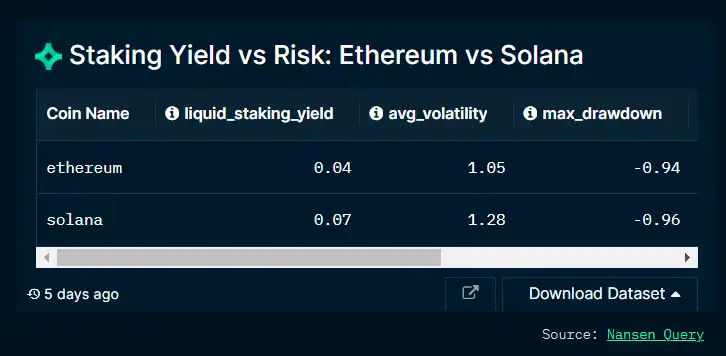
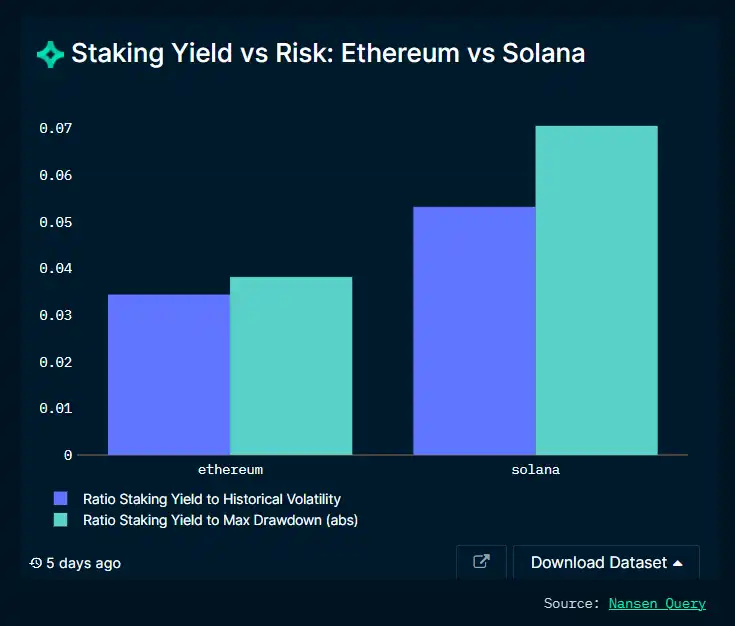
The Solana network currently has a total of 295.7 million staked SOL tokens, but the use of liquidity staking derivatives is still very limited. The liquidity staking space on Solana was impacted by FTX (crypto exchange platform), reaching a peak TVL of 12.8 million SOL, but dropping to 5 million SOL during market crashes. However, since then, liquidity staking activity has fully recovered, returning to levels above 12 million SOL.
We have also seen new participants in liquidity staking protocols, such as Jito, a staking service provider, which has accumulated over $44.86 million (2.3 million SOL) in TVL since its launch at the end of November last year. Additionally, the growth of liquidity staking derivatives (LSD) and DeFi use cases has been significant, with some DeFi protocols allowing users to deposit their SOL LSD tokens and use them as trading collateral (in perpetual contracts) or for lending activities on lending platforms.
Marinade Finance still holds the majority of the market share in the Solana liquidity staking space, locking in over 5.47 million SOL tokens, followed by Lido and Jito. It is worth noting that more liquidity staking protocols, such as Marinade, Socean, Lido, BlazeStake, and Jito, are emerging and offering different reward programs to attract more users to stake SOL tokens.
Marinade's new project "Marinade Native" allows users to delegate staking rights while retaining withdrawal rights. As part of their incentive program, Marinade also announced the "Marinade Earn" program, which will run from October 1, 2023, to January 1, 2024. During this period, users holding mSOL or Marinade Native tokens will receive a reward of 1 MNDE/SOL (approximately 3 months). There is also a referral system where referrers can earn a reward of 1 MNDE/SOL through their unique referral link.
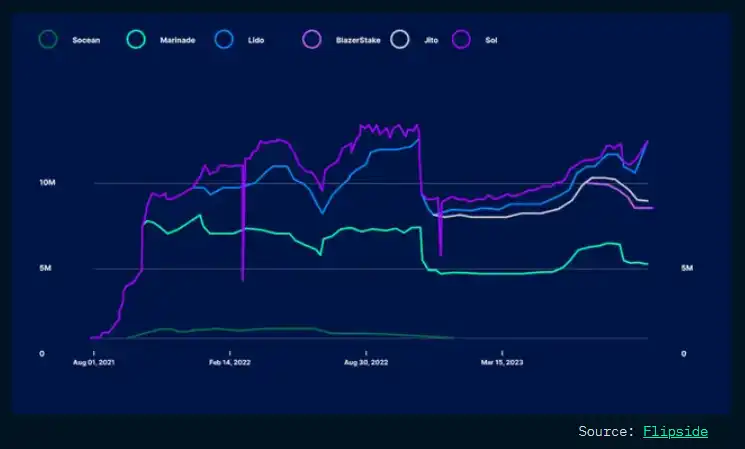
Speaking of "newcomers," Jito reached an all-time high TVL of $57.5 million on October 2, 2023, with 2.4 million SOL tokens staked, showing a consistent upward trend since its launch. In the third quarter, the total TVL increased by 100%, from 740,000 SOL to 1.62 million SOL.
Jito is Solana's first staking product with MEV rewards. Users can stake their Solana tokens in exchange for LSD tokens JitoSOL.
JitoSOL has two main advantages:
- JitoSOL provides additional rewards for users conducting MEV trades on Solana.
- Jito stakes on validators running specially designed software to improve network performance.
Based on the amount of JitoSOL deposits, the leading projects have over 750,000 SOL, with the following market shares:
- Marginfi - 250,000 SOL
- Drift Protocol - 225,000 SOL
- Squads Protocol - 146,000 SOL
- Orca - 51,000 SOL
- And 30 other projects
BlazeStake is another new entrant in the market, experiencing over a 10x increase in TVL since its launch, growing from $631,000 to $10.68 million at the time of writing. SolBlaze has launched its native token BLZE and plans to introduce new features for its platform, including BLZE Gauges, and incentive programs for staking. The estimated APY for staking on the SolBlaze platform is approximately 9.37% (with about 2.13% coming from BLZE).
Hyperledger Solang
Solana is known for its use of Rust or C programming languages for smart contracts. Recently, Hyperledger Solang has been introduced to allow developers from EVM chains to deploy their dApps on Solana without needing to learn a new language. Hyperledger Solang lowers the barrier for developers, making Solana a more accessible blockchain to build on. However, it is currently unclear how this will impact developer activity on Solana.
Upcoming Catalysts
Emerging Solana DeFi Applications
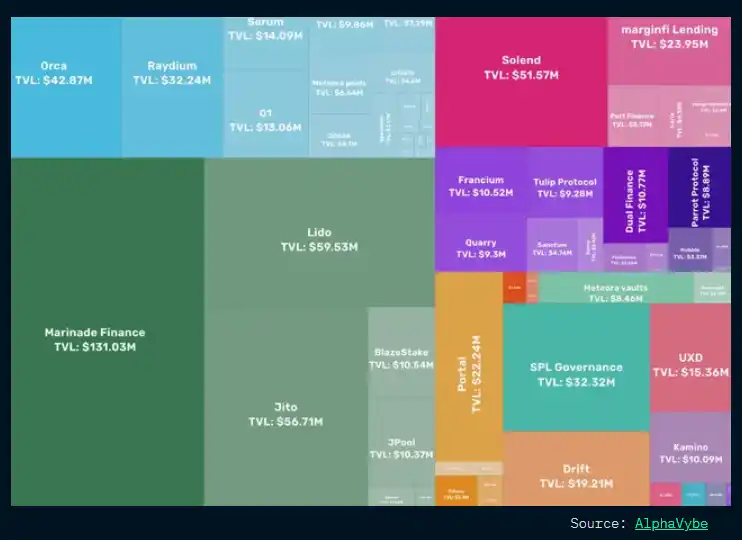
Phoenix
Phoenix is a decentralized limit order book on Solana that supports spot asset markets. Built by the Ellipsis Labs team, which recently completed a $3.3 million funding round led by Electric Capital, Phoenix is fundamentally betting on the growth of Solana-native assets. The Phoenix project serves as their entry into the decentralized trading platform, with the team believing that market creation should be permissionless. All market events (placing limit orders, canceling limit orders, trades, etc.) are recorded on-chain, allowing traders to easily query real-time and historical states of all Phoenix markets.
Drift Protocol
Drift Protocol is a derivatives trading platform on Solana. Drift v2 has recently surpassed $1 billion in cumulative trading volume, with open interest at $4.9 million. The total locked value in Drift has grown by over 50% in the past month (measured in USD and SOL). Overall, Drift Protocol has shown strong growth across various metrics.
In addition to high-level statistics, Drift has also launched CONNECT, an open-source Metamask plugin that allows users of the Metamask wallet to bridge between EVM chains and Solana. Additionally, Drift plans to support permissionless prediction markets in the future, which is still in the early discussion stage.
Squads Protocol
Squads Protocol has just launched its new platform, an exclusive comprehensive multisig platform in the Solana ecosystem. Squads Protocol has garnered $600 million in assets and a total trading volume of $9.5 billion.
Kamino Finance
Kamino is an automated liquidity solution that allows users to earn yield by providing liquidity to centralized liquidity markets. In the third quarter, Kamino Finance facilitated over $1 billion in trades and generated $1.25 million in fees for its depositors. Kamino Finance's v2 is highly anticipated and is planned for release in the fourth quarter.
Scoring Systems for DeFi Protocols
Scoring systems allow protocols to test different incentive mechanisms, allowing them to evaluate what is effective and what is not. So far, the system has been largely tested and trialed by NFT protocols led by Tensor and Blur. We still need to see the adoption of these scoring systems in Solana DeFi applications.
MarginFi
MarginFi, a lending market, has introduced a scoring system in the Solana DeFi space, with other protocols following suit. The scoring system was inspired by the renowned NFT platforms Blur and Tensor but has been improved and applied in DeFi protocols. Following MarginFi, several Solana DeFi protocols have started rolling out their own scoring programs, including Cypher, Solend, and Jito.
MarginFi's system introduces a scoring system similar to Swell Network, where every dollar borrowed accumulates 1 point per day, while every dollar lent accumulates 4 points per day. Borrowing earns more points, as it is a primary driver of success for lending protocols.
Cypher
Cypher previously experienced explosive TVL growth but later faced platform security vulnerabilities. Despite a rollback due to the exploitation of the vulnerabilities, Cypher later resolved most issues and restarted operations.
Cypher's scoring system is allocated to trading, borrowing, and lending on the platform. For scoring in spot and perpetual markets:
· Perpetual Markets
Maker trading volume: 20 points per $1 of trading volume
Taker trading volume: 15 points per $1 of trading volume
· Spot Markets
Maker trading volume: 10 points per $1 of trading volume
· Lending Markets
Borrowing: 5 points per $1 borrowed per day
Lending: 1 point per $1 lent per day
Solend
Solend takes a unique approach, with Solend Points having the lowest reward pool and being divided by "seasons." Season 1 will start with 100,000 SLND and grow with more partners and transactions.
· Lending/Borrowing Markets
10 million points are allocated daily, distributed based on the supply and borrowing ratio. Borrowing is twice the supply.
· Leveraged Trading
10 points can be earned per $1 of leveraged trading volume
Jito
Jito launched Jito Points on September 28, allowing users to compound their jitoSOL assets. Bonus/point allocation includes:
· Liquidity providers in any JitoSOL/xSOL trading pair receive 1.5x points
· Liquidity providers in JitoSOL/SOL receive 2.5x points
· Liquidity providers in JitoSOL/USDC and other volatile trading pairs receive 3.5x points
Potential strategies (not financial advice):
Provide JitoSOL liquidity on these integrated protocols:
· Kamino Finance
· Meteora
· Orca
· Raydium Protocol
· Drift Protocol
Firedancer: When Will It Reach Over 1 Million Transactions Per Second?
Firedancer is a Solana validator client developed by Jump Crypto, aimed at further reducing latency and increasing client diversity on Solana. To effectively achieve the goal of 1 million transactions per second, the network needs to scale load balancing. Firedancer leverages hardware and software upgrades to scale load balancing. In this report, we will not delve into the details of Firedancer and its implementation.
Firedancer will release its components in phases.
The implementation of the QUIC transaction propagation protocol marks the first step in the development of Firedancer. In performance testing, "fd_quic" showed a propagation throughput of 1 million transactions per second.
The goal is to recreate each component of the Solana architecture to fully realize the potential of Firedancer. QUIC marks the first step in recreating each validator component, and the release date for the comprehensive technology is currently unclear.
Conclusion
Solana has achieved a series of key technological milestones, addressing challenges and pioneering potential future directions for infrastructure, applications, and even partnerships with traditional financial sectors. Despite facing various technical and network challenges in the past, Solana's strong technology stack and commitment to improvements, such as the implementation of QUIC, have greatly alleviated concerns.
The growing Total Value Locked (TVL), leading DeFi transaction speeds, and stable monthly transaction data highlight the chain's potential to become a hub for diverse economic activities. Decentralization metrics, such as the Nakamoto coefficient, reveal the chain's commitment to creating a more distributed ecosystem.
The ecosystem is supported by various partnerships and technological advancements. From the promising state compression technology (which can significantly reduce NFT minting costs) to the expectations for Firedancer and its potential to further optimize the Solana experience, the chain continues to innovate. Integrations with Metamask Snaps and developments like Hyperledger Solang also suggest Solana's efforts to become more EVM-friendly.
So far, Solana's development journey represents a broader evolution of blockchain, full of hope, occasional challenges, but continuous growth. Like any emerging technology, the road ahead is filled with uncertainty. The upcoming liquidation of FTX/Alameda SOL holdings by Galaxy may represent a potential inflection point on Solana's timeline. However, Solana's commitment to innovation, adaptability, and user-centric focus implies promising development prospects for this blockchain contender.
免责声明:本文章仅代表作者个人观点,不代表本平台的立场和观点。本文章仅供信息分享,不构成对任何人的任何投资建议。用户与作者之间的任何争议,与本平台无关。如网页中刊载的文章或图片涉及侵权,请提供相关的权利证明和身份证明发送邮件到support@aicoin.com,本平台相关工作人员将会进行核查。




